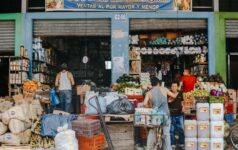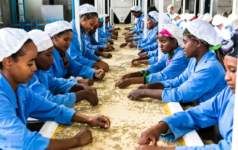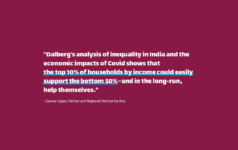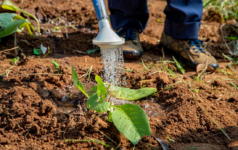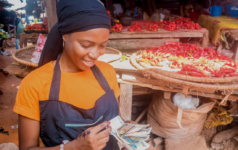Dalberg uses cookies and related technologies to improve the way the site functions. A cookie is a text file that is stored on your device. We use these text files for functionality such as to analyze our traffic or to personalize content. You can easily control how we use cookies on your device by adjusting the settings below, and you may also change those settings at any time by visiting our privacy policy page.
An estimated 90 percent of smallholder farmers lack strong, consistent relationships with buyers – and the access to finance, inputs, agronomic training and other support that typically accompanies those relationships.
The way these smallholders operate – outside a tight value chain, on a relatively small landholding, and with limited commercial activity – makes it difficult for financial providers to reach them. Direct-to-farmer finance is an important pathway through which these farmers can gain access to credit and other financial services that will help them improve their yields and lives. A new briefing from the Initiative for Smallholder Finance explores the over 150 finance providers who offer finance directly to smallholder farmers globally.
These “direct-to-farmer finance providers” range from state and agricultural development banks, to informal financial institutions, and everywhere in between. Through our research, we observed that providers’ specific approaches to direct-to-farmer finance cluster around four business model archetypes: Build & Integrate, Build & Partner, Leverage & Network, and Extend & Mobilize.
Understanding the following four archetypes can help funders, investors and finance providers better align models across smallholder farmer segments and identify opportunities to address scaling challenges:
1. Build & Integrate: These financial providers aim to fill a market gap by serving primarily non-commercial smallholders with little to no access to finance and farming-related services. Field-based staff deliver financial products, typically developed specifically to support smallholders’ agricultural needs, as well as agronomic training and other support services. The hands-on and field-based nature of Build & Integrate providers’ approach helps them build strong relationships with smallholders and a deep understanding of their financial and non-financial needs. However, this approach also translates to a low farmer-to-field officer ratio of approximately 100-200 farmers per field officer – the lowest observed across archetypes. One example of a Build & Integrate financial provider is One Acre Fund, which is serving more than 180,000 farmers across Kenya, Tanzania, Burundi and Rwanda.
2. Build & Partner: These financial providers also aim to fill a market gap by serving rural populations, including both non-commercial smallholders and commercial smallholders in loose value chains. Similar to the Build & Integrate model, these providers operate in close proximity to clients, delivering financial products through field-based staff. However, Build & Partner providers typically outsource the development and delivery of agronomic training and other support services through formal partnerships. As providers’ staff operate in the field but are primarily responsible for financial activities only, Build & Partner providers typically have farmer-to-field officer ratios of approximately 300-500 farmers per field officer – higher than those of Build & Integrate providers. Juhudi Kilimo, a non-bank financial institution offering asset financing to Kenyan smallholders, is an example of a Build & Partner financial provider.
3. Leverage & Network: These financial providers use existing infrastructure to broaden their client base by serving commercial smallholders, including some in loose value chains. To do so, providers typically deploy existing capital sources (including revenue, client savings and investment capital) and staff to deliver a full set of financial products to smallholders. Most Leverage & Network providers serve smallholders from branches and seek out informal partnerships with other organizations who that can provide training and other agronomic support to their clients. Given these factors, Leverage & Network providers typically have the highest farmer-to-field officer ratios: more than 1,000 farmers per field officer. Opportunity International and its network of financial institutions offering smallholder finance across seven African countries are examples of Leverage & Network providers.
4. Extend & Mobilize: These financial providers are typically member-run organizations set up to meet the needs of the rural communities in which they operate. Thousands of these providers exist – including Village Savings and Loans Associations (VSLAs) and Savings and Credit Cooperatives (SACCOs) – and some have extended their financial product offerings to include agricultural-focused products for non-commercial smallholders. Most Extend & Mobilize providers depend on their existing staff and capital base (typically member savings) to support their agricultural finance activities. Agronomic supporting services are typically member driven and provided more informally on a volunteer basis.
Taking direct-to-farmer finance to the next level
While each business model archetype has strengths and merit, each also faces significant limitations to scale, as our briefing explores in greater detail.
To overcome these challenges and close the enormous gap that persists between demand for and supply of smallholder finance, finance providers will need to share knowledge and blend approaches across business model archetypes. Funders and investors can encourage this activity by supporting knowledge-sharing platforms and activities among providers, and working with individual direct-to-farmer finance providers to experiment with practices more commonly observed in other business model archetypes.
Funders and investors also can support ongoing and future innovation to help providers overcome challenges and scale more quickly. The Direct to Farmer Finance: Innovation Spaces Playbook from the Initiative for Smallholder Finance, describes these innovation opportunities in greater detail and suggest compelling new directions in which practitioners could build off of current activity.

